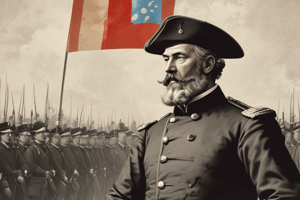Podcast
Questions and Answers
Chi era un sostenitore dell'unificazione italiana e ha guidato un tentativo fallito di insurrezione a Genova nel 1834?
Chi era un sostenitore dell'unificazione italiana e ha guidato un tentativo fallito di insurrezione a Genova nel 1834?
- Napoleone Bonaparte
- Count Cavour
- Giuseppe Mazzini
- Giuseppe Garibaldi (correct)
Quale movimento storico è conosciuto anche come Risorgimento?
Quale movimento storico è conosciuto anche come Risorgimento?
- Rivoluzione Russa
- Revoluzione Francese
- Guerra dei Cent'anni
- Unificazione dell'Italia (correct)
Chi era un monarca liberale che desiderava un'Italia unita sotto una costituzione governata dal re del Piemonte-Sardegna?
Chi era un monarca liberale che desiderava un'Italia unita sotto una costituzione governata dal re del Piemonte-Sardegna?
- Count Cavour (correct)
- Giuseppe Garibaldi
- Napoleone Bonaparte
- Giuseppe Mazzini
Da dove proveniva Giuseppe Garibaldi, importante protagonista del movimento per l'unificazione italiana?
Da dove proveniva Giuseppe Garibaldi, importante protagonista del movimento per l'unificazione italiana?
Chi era un radicale combattente che guadagnò fama internazionale dopo aver combattuto in Sud America?
Chi era un radicale combattente che guadagnò fama internazionale dopo aver combattuto in Sud America?
Quali erano i principali fattori che hanno guidato il movimento per l'unificazione italiana?
Quali erano i principali fattori che hanno guidato il movimento per l'unificazione italiana?
Chi fu uno dei leader del movimento Risorgimento che giocò un ruolo cruciale nell'unificazione dell'Italia?
Chi fu uno dei leader del movimento Risorgimento che giocò un ruolo cruciale nell'unificazione dell'Italia?
Dove si rifugiò Garibaldi per evitare l'esecuzione e in seguito combatté nelle guerre di indipendenza in America del Sud?
Dove si rifugiò Garibaldi per evitare l'esecuzione e in seguito combatté nelle guerre di indipendenza in America del Sud?
Quale atto pose fine allo Stato Pontificio e contribuì all'unificazione dell'Italia?
Quale atto pose fine allo Stato Pontificio e contribuì all'unificazione dell'Italia?
Quale guerra portò alla formazione di un'alleanza tra la monarchia sarda e nazionalisti radicali come Garibaldi contro l'Austria e la papà?
Quale guerra portò alla formazione di un'alleanza tra la monarchia sarda e nazionalisti radicali come Garibaldi contro l'Austria e la papà?
Chi fu un celebre generale e combattente guerrigliero che divenne una celebrità internazionale grazie alle sue gesta?
Chi fu un celebre generale e combattente guerrigliero che divenne una celebrità internazionale grazie alle sue gesta?
Quale movimento giocò un ruolo cruciale nella trasformazione della penisola italiana da una collezione di città-stato e regni in una nazione unificata?
Quale movimento giocò un ruolo cruciale nella trasformazione della penisola italiana da una collezione di città-stato e regni in una nazione unificata?
Study Notes
The Unification of Italy: A Historical Overview
The unification of Italy, also known as the Risorgimento, was a complex process that took place from 1815 to 1870. This period saw the transformation of Italy from a collection of city-states and kingdoms into a single, unified nation. The movement was driven by a variety of factors, including nationalism, political and economic reforms, and foreign influence.
The Risorgimento Movement
The Risorgimento movement was a revival of Italian nationalism that aimed to unite the Italian peninsula under a single government. This movement was influenced by the French Revolution and the Napoleonic Wars, which exposed many Italians to the idea of a unified Italy. The Risorgimento was led by a diverse group of individuals, including Count Cavour, a liberal monarchist who wanted a united Italy under a constitution ruled by the king of Piedmont-Sardinia; Giuseppe Mazzini, a republican who refused to compromise on his ideals and wanted an Italian republic; and Giuseppe Garibaldi, a true radical who fought in South America and became an international celebrity.
Giuseppe Garibaldi
Giuseppe Garibaldi was a key figure in the Risorgimento movement. Born in Nice, then part of the Kingdom of Sardinia, Garibaldi was a strong advocate for Italian unification. In 1834, he led an uprising in Genoa that was unsuccessful, resulting in his sentence to death. Rather than face execution, Garibaldi fled to South America, where he fought in the wars of independence in Uruguay and Brazil. He became a brilliant general and guerilla fighter, and his exploits made him an international celebrity.
Wars of Italian Unification
The process of Italian unification involved several wars, including the First Italian War of Independence (1848-1849) and the Second Italian War of Independence (1859-1861). These wars were fought against Austria and the papacy, with the Sardinian monarchy eventually forming an alliance with more radical nationalists like Garibaldi. The final act of unification came in 1870, when the king of Italy annexed Rome, effectively ending the papal states and uniting the country.
The unification of Italy was a significant achievement that transformed the Italian peninsula from a collection of city-states and kingdoms into a single, unified nation. This process was driven by a variety of factors, including nationalism, political and economic reforms, and foreign influence. The Risorgimento movement, led by figures like Cavour, Mazzini, and Garibaldi, played a crucial role in this transformation, ultimately leading to the establishment of the Kingdom of Italy in 1870.
Studying That Suits You
Use AI to generate personalized quizzes and flashcards to suit your learning preferences.
Description
Scopri di più sull'unificazione dell'Italia, un processo che trasformò la penisola italiana da una serie di città-stato e regni in una singola nazione unita. Con il Risorgimento come movimento chiave, guidato da figure come Cavour, Mazzini e Garibaldi, l'Italia raggiunse finalmente l'unità nel 1870.



